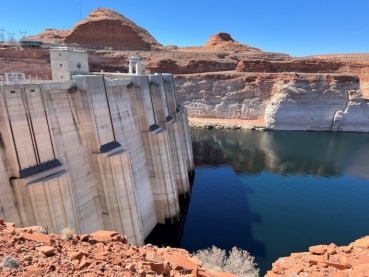 By Miriam Raftery
By Miriam Raftery
Photo: Glen Canyon Dam at Lake Powell, April 2022 levels, courtesy Bureau of Reclamation
June 17, 2022 (San Diego) – The U.S. Senate held a hearing this week on dire water shortages in the West, including critically low water shortages at the Colorado River, which provides water to cities across the Southwest including San Diego. As Senators sought solutions including acceleration of infrastructure projects, one bright spot came in testimony from San Diego County Water Authority’s general manager Sandra L. Kerl, who illustrated how our region’s investment in innovation, conservation and water reclamation have provided sustainable water solutions in a model that could be emulated in other areas.
Kerl first laid out the problem in stark terms. “The water situation across the state and Southwest is dire, as historically dry conditions exacerbated by climate change shrink water storage levels at Lake Mead and Lake Powell and threaten the loss of power generation,” she told Senators. “One look at the river system today communicates as no words can, how devastating these impacts are and the need for all parties – the seven Basin states, federal government, tribal nations and our neighbor to the south, Mexico – to make the kind of changes needed to ensure that this precious resource will be available for future generations.”
Her words echoed those of Bureau of Reclamation Commissioner Camille Calimlim Touton, who testified that large reductions in water deliveries are needed due to the nation’s largest reservoirs, Lake Mead and Lake Powell, having water fall to critical levels posing challenges “unlike anything we have seen in our history.”
California gets 4.4 million acre-feet of Colorado River water a year, while Arizona gets 2.8 million. But Touton warned that cuts between 2- and 4-million-acre feet will be needed next year from Colorado River water supplies – more than the total both states traditionally have received, combined.
Already, California, Arizona and Nevada have signed a pact to take less water from Lake Mead, but more is needed, since Lake Powell has fallen so low that there is a risk of the Glen Canyon Dam no longer having enough water to generate electricity, the Los Angeles Times reports. Lake Powell is now at just 27% of its capacity. The federal government is in negotiations with seven states to further cut water usage, but mandatory cuts loom if those talks prove unsuccessful.
“We are 150 feet from 25 million Americans losing access to the Colorado River, and the rate of decline is accelerating,” testified John Entsminger, general manager of the Southern Nevada Water Authority which provides water to Las Vegas. Cuts could devastate agriculture, which receives 80% of the Colorado River’s flow for crops including alfalfa, a primary feed for cattle.
Solutions could include the federal government investing to help states or local governments build new wastewater recycling facilities,
Kerl testified how San Diego foresaw such problems – and took action.
“Two decades ago, after experiencing severe drought and shortages in our own local water supplies, the Water Authority Board of Directors and San Diego County ratepayers made the difficult decision to simultaneously invest in the largest water conservation program in the West, while reducing per capita local water consumption by more than 40%,’ she testified, adding, “It hasn’t been easy, but the fruits of our labor have been realized by dramatic increases in efficiency in agricultural production in Imperial County and by securing a highly reliable water supply for San Diego County.”
That’s included raising the dam at the San Vicente Reservoir in Lakeside to increase local water storage capacity and investing in the PureWater treatment system to convert wastewater to drinking water, a system that has broken ground and is slated to come on line in the near future.
Thanks to the steps taken so far, Kerl noted, “Land was not fallowed, people did not lose their jobs and all environmental impacts were fully accounted for.”
San Diego’s water conservation agreement with the Imperial Irrigation District was made possible by legislation passed decades ago in Sacramento that can be a model for how to sustain environmental, agricultural, and urban water needs while using significantly less water, she explained, praising the leadership of Governor Gavin Newsom and Adel Hagekhalil at the helm of the Metropolitan Water District.
“The state and all Southern California are poised for innovation and to build on this successful model,” Kerl told Senators. But she advised, “Our public policy must be focused first on making conservation and reclamation work, and on recognizing that that it will cost money. We cannot succeed with policies that unintentionally fail to connect the benefits of conservation to the ratepayers who foot the bill.”
She concluded by stating that the San Diego County Water Authority is fully committed to “working together with all parties to promote innovation and to the long-term sustainability of our most precious resource, and to protecting the human right to water,’ adding, “Our collective success is vital to our communities, farms, environment and the economy.”







Recent comments